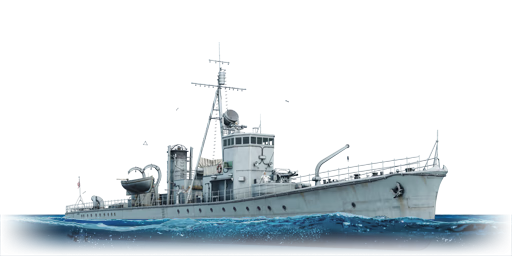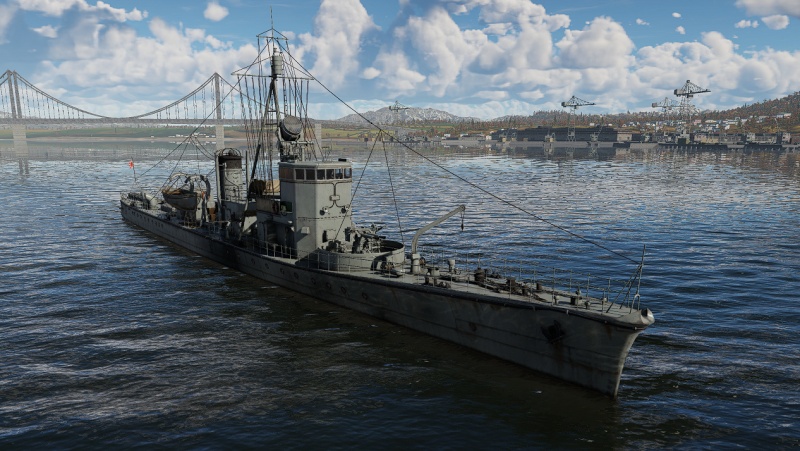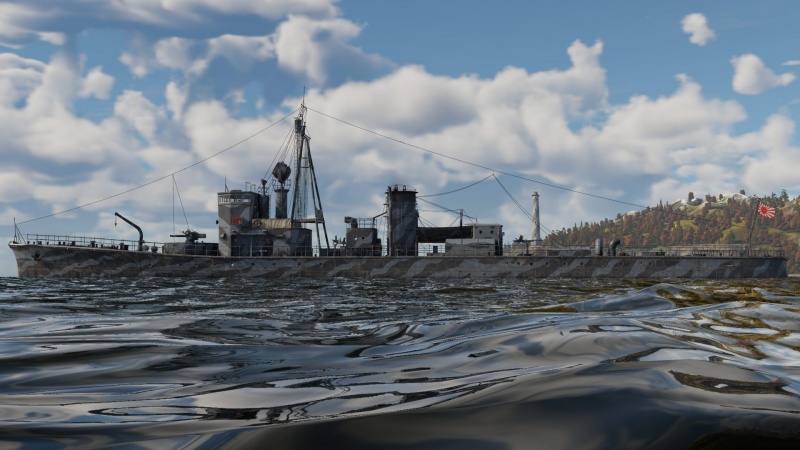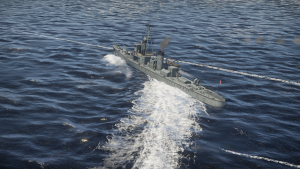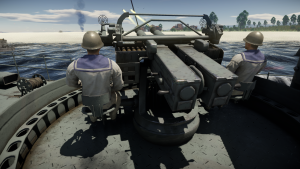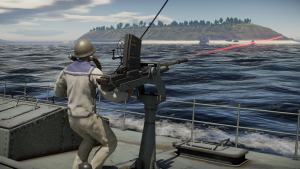Type K-3 No.1
Contents
Description
The Project K3, No.1-class Submarine Chaser No.1 was completed in March 1934 as a part of the Maru 1 Programme. It was the first class of the dedicated Anti-Submarine Warfare vessels in the Imperial Japanese Navy. The major advantage of the vessel was its high speed, while the key issue was a problem with the strength of the hull, which was later addressed in refits, modification of the No.3 subclass before it was built and finally, fully resolved in the No.4-class. She spent most of her service in the southern seas, survived the war without any notable successes, and finally was scuttled by the Royal Navy off Singapore.
The Type K-3 No.1, Kusentei was introduced in Update 1.89 "Imperial Navy". The ship has a powerful and varied combination of weapons, as well as good survivability compared to the other vessels in her BR. Her main disadvantages come from being such a large vessel - she has a low manoeuvrability and is easy to hit with nearly anything, from bombs, through rockets to artillery strikes.
General info
Survivability and armour
Relatively well-armoured, large ship with high survivability for its rank. Its major weakness is in being prone to fires. Major strength in a high crew count of 65, one of the largest in its battle rating class (after HMCS Brantford). Weapons are relatively well distributed, making them a difficult targets to take down separately. While the ship itself is large in size, its frontal cross-section is relatively small, making it a tricky target in a hands of a more experienced player. Secondary anti-aircraft armament, while powerful, is centred around sides, making ship most prone to the attacks from a rear. Another potential weak-point are ammunition racks exposed over the water line, however those can be minimized by reducing the ammunition count by half.
Mobility
While the ship is relatively large it's still characterized with a comparatively high manoeuvrability. While the base speed is 44 km/h, a fully-upgraded setup can reach an impressive maximum speed of 59 km/h. Combined with a Rudder Replacement K-3 can choose engagements even with a number of torpedo boats.
| Mobility Characteristics | |||
|---|---|---|---|
| Game Mode | Upgrade Status | Maximum Speed (km/h) | |
| Forward | Reverse | ||
| AB | |||
| Upgraded | 59 | 22 | |
| RB/SB | |||
| Upgraded | 39 | 14 | |
Modifications and economy
Armament
Primary armament
Primary weapon is a relatively low-shell-speed, high-arcing, high rate of fire dual-barrel 40 mm Vickers autocannon. It's an excellent weapon for relatively quickly dispatching targets within 1.5 km range, where its high rate of fire can be used to correct lead and land number of shots before the need to reload. It's extremely useful against small fast vessels, such as hydrofoil torpedo boats. At range however, the flight time becomes a near-impossible for tracking anything smaller than a sub-chaser. There is, however, one advantage to the gun at >1,500 m range: due to its low shell speed gun will fire at a very high arc, allowing K-3 to be one of a very few ships within its rank capable of reaching enemies hidden behind near-vertical obstacles, making it an excellent weapon to use against various opponents trying to hide behind the islands or other terrain obstacles.
- Universal: HEF · APHE · HEF · APHE
- 40 mm HE clips: HEF · HEF · HEF · APHE
- 40 mm AP clips: APHE · APHE · APHE · HEF- Armour piercing shells, good at damaging interior modules and armoured ships
- 40 mm HE-TF clips: HE-TF · HE-TF · HE-TF · HE-TF- Dual-fuze HE shells, meaning they are effective against both boats and aircraft, generally superior to the HEF clip
| Penetration statistics | |||||||
|---|---|---|---|---|---|---|---|
| Ammunition | Penetration @ 0° Angle of Attack (mm) | ||||||
| 10 m | 100 m | 500 m | 1,000 m | 1,500 m | 2,000 m | ||
| APHE | 36 | 35 | 29 | 22 | 18 | 14 | |
| HEF | 3 | 3 | 3 | 3 | 3 | 3 | |
| HE-TF | 3 | 3 | 3 | 3 | 3 | 3 | |
| Shell details | ||||||||||||
|---|---|---|---|---|---|---|---|---|---|---|---|---|
| Ammunition | Velocity (m/s) |
Projectile mass (kg) |
Fuse delay (m) |
Fuse sensitivity (mm) |
Explosive mass (TNT equivalent) (g) |
Ricochet | ||||||
| 0% | 50% | 100% | ||||||||||
| APHE | 600 | 0.78 | 1 | 3 | 23 | 47° | 60° | 65° | ||||
| HEF | 600 | 0.79 | 0 | 0.1 | 70 | 79° | 80° | 81° | ||||
| HE-TF | 600 | 0.79 | 0 | 0.1 | 70 | 79° | 80° | 81° | ||||
Secondary armament
The Type K-3 No.1 possesses some of the best anti-air armament among Japanese rank 1 ships, making it extremely useful in fending-off enemy ships, even armoured gun boats, and relatively useful against air targets. The only disadvantage is in the guns layout, where at most 2 guns can be firing at a target, due to the fact that two guns amid-ship are pointing in the opposite directions, without any overlapping field of fire.
- Universal: HEF-T* · HEF · AP-T · HEI
- 25 mm APT belt: AP-T · AP-T · AP-T · HEF
- 25 mm HEIT belts: HEF-T* · HEI · HEI · HEI
| Penetration statistics | |||||||
|---|---|---|---|---|---|---|---|
| Ammunition | Penetration @ 0° Angle of Attack (mm) | ||||||
| 10 m | 100 m | 500 m | 1,000 m | 1,500 m | 2,000 m | ||
| HEF-T* | 2 | 2 | 2 | 2 | 2 | 2 | |
| HEI | 2 | 2 | 2 | 2 | 2 | 2 | |
| HEF | 2 | 2 | 2 | 2 | 2 | 2 | |
| AP-T | 55 | 53 | 43 | 33 | 25 | 19 | |
| Shell details | ||||||||||||
|---|---|---|---|---|---|---|---|---|---|---|---|---|
| Ammunition | Velocity (m/s) |
Projectile mass (kg) |
Fuse delay (m) |
Fuse sensitivity (mm) |
Explosive mass (TNT equivalent) (g) |
Ricochet | ||||||
| 0% | 50% | 100% | ||||||||||
| HEF-T* | 900 | 0.24 | 0 | 0.1 | 8.5 | 79° | 80° | 81° | ||||
| HEI | 900 | 0.26 | 0 | 0.1 | 5.52 | 79° | 80° | 81° | ||||
| HEF | 900 | 0.25 | 0 | 0.1 | 23.93 | 79° | 80° | 81° | ||||
| AP-T | 900 | 0.28 | - | - | - | 47° | 60° | 65° | ||||
Additional armament
Describe the available additional armaments of the ship: depth charges, mines, torpedoes. Talk about their positions, available ammunition and launch features such as dead zones of torpedoes. If there is no additional armament, remove this section.
Usage in battles
The K-3 is largely a support ship that excels in one-on-one fights in similar or lower battle ratings, while still being useful in higher-BR battles. It's ill-advised to rush capture points in this ship due to its large size that makes for an attractive target to the enemy team. It's a particularly difficult vessel to play until unlocking fire protection system, as it's extremely easy to ignite and fires will quickly take it down - for that reason when fighting against Type K-3 it's highly recommended to use HE shells on every occasion.
The sub-chaser's primary advantage is in a very narrow hull and an outstanding 40 mm gun. The ship is so narrow in fact that it's near-impossible to hit for a motor torpedo boats when facing bow (front) or stern (rear). On the other hand, its length is one of, if not the longest in BR, being a serious issue when faced with torpedoes or high-rank ships, therefore care should the taken to pre-emptively position oneself when engaging opponents.
The ship is best taken equipped with less than a half of a total ammunition capacity, as it's more than sufficient for a vast majority of battles, while significantly lowers the cross-section of the unarmoured ammunition racks that are prone to explosions. Also ignoring depth charges is recommended due to their extremely limited usefulness while adding mass and risk of explosion to the ship.
It's generally good to have at least some HE-DF ammunition onboard, as with a rapid fire of the 40 mm Vickers it can dispatch a field of flak fire very effectively destroying enemy bombers and fighters, or at least scaring them off. Within Rank 1 battles 40 mm HE clips are a better choice than the Universal or SAP, as none of the targets will have enough armour to resist them even at 2,000 m, while additional explosive power increases the speed in which enemies can be destroyed. Primary gun is positioned at the front of the vessel, making it possible to peek from cover and shoot, without exposing much of a vessel. High firing arc makes it possible to shoot from behind cover of a small islands and to attack enemies inaccessible to the ships with higher shell speed.
Both K-3 and K-7 have a relatively undefended rear arc, where at most only one 20 mm anti-aircraft gun can shoot back.
Pros and cons
Pros:
- Effective 40 mm twin cannon with high firing arc and rapid fire
- Secondary armament is very powerful against small ships and unsuspecting bombers
- Decent anti-aircraft artillery for its battle rating
- Decent speed
- Possesses one of the highest crew count in its rank
- HE-DF rounds are very useful against enemy vessels in close quarter battles
Cons:
- Low manoeuvrability
- Large target
- Primary armament is not very effective against larger, well-armoured ships
- Low shell speed makes for a challenging gameplay when up-tiered
History
The No.1-class submarine chasers (第一号型駆潜艇, Dai 1 Gō-gata Kusentei) were built under Maru 1 Keikaku programme, totalling 2 ships built in 1933. Vessels suffered from stability and hull strength issues that were resolved in a later redesign that became the No.4. The ship is a flush deck design with a relatively high freeboard for its size and an unproportionally large bridge. Ship's waterline length was 64 m, width 5.6 m for a total displacement of 383 tonnes. Crew consisted of 53 sailors, with up to 65 capacity.
Designers considered one of two primary guns against surfaced submarines: Either 8 cm/40 3rd Year Type naval gun or Type Bi-4 cm autocannon, which they've eventually picked for the final design. Both proposed guns were built domestically in Japan on a license. Additionally armament featured two imported Lewis light machine guns with the third one added during the war. Ships were equipped with 36 depth charges released overboard (projectors were added in the No.4). Additional equipment included Type 91 sonar, Type MV hydrophone, 6m motor boat and a 6m cutter, 60 mm search and signal light and an additional 30 mm search light.
The first ship was commissioned on 23 December 1933, numbered No.2 by the Tōkyō Ishikawajima Shipyard, followed 3 days later by No.1 from the Uraga Dock Company. Both ships participated in the events following the Marco Polo Bridge Incident in the 1938. In 1941 ships participated in the Operation M, and for the remaining of the Pacific War they've took part in convoy escorts around the region.
On 27 June 1945 No.2 was struck by a 533 mm torpedo from the Balao-class submarine USS Blueback. No.1 survived the war meeting end of it in a city of Surabaya on a Philippines island of Java. It eventually was scuttled in the Singapore by the Royal Navy.
Media
- Skins
See also
- Ships of comparable role, configuration and era
External links
- [Wikipedia] No.1-class submarine chaser
- [Imperial Japanese Navy Page] IJN Subchaser CH-1: Tabular Record of Movement
- Ships of the World - Escort Vessels of the Imperial Japanese Navy (Special Issue Vol. 45) (世界の艦船 - 日本海軍護衛詳艇史 (増刊第45集條 1996.No.507)) page 66.
| Uraga Dock Company (浦賀船渠株式会社) | |
|---|---|
| Sub Chasers (駆潜艇) | |
| No.1 Type | Type K-3 No.1 |
| Destroyers (DD) | |
| Hatsuharu-class | IJN Nenohi |
| Yugumo-class | IJN Kiyoshimo |
| Light Cruisers (CL) | |
| Nagara-class | IJN Isuzu |
| Japan sub-chasers | |
|---|---|


